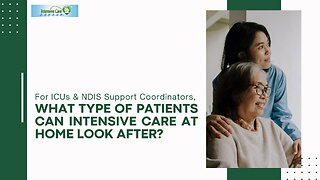Premium Only Content

Can INTENSIVE CARE AT HOME Look After Ventilated/Tracheostomy Clients with Diaphragmatic Pacer?
Can INTENSIVE CARE AT HOME Look After Ventilated/Tracheostomy Clients with Diaphragmatic Pacer?
Book your free 15-minute phone consultation here
http://intensivecarehotline.com/scheduling-appointment/
Call directly 24/7
+1 415-915-0090 USA/Canada
+44 118 324 3018 UK
+6141 094 2230 Australia
Email support@intensivecarehotline.com
Get 1:1 consulting and advocacy
1:1 phone counselling
http://intensivecarehotline.com/one-on-one-counselling/
Become a member for families of critically ill Patients in Intensive Care
https://intensivecarehotline.com/intensivecaresupport-org-membership/
Immediate action steps http://intensivecarehotline.com/take-control-take-charge/immediate-action-steps/
https://intensivecareathome.com
And if you need a medical record review, click on the link and we can help you with reviewing your loved one’s medical records while they’re in ICU.
https://intensivecarehotline.thrivecart.com/review-of-medical-records/
Facebook Page: https://www.facebook.com/ICUhotline
Twitter: https://twitter.com/icuhotline
Song: Jarico - Island Music
supported by@FreeBackgroundMusicForCreators
#BackgroundMusicWithoutLimitations
https://bit.ly/2XoXFnb
#icu
#intensivecare
#criticalcare
If you want to know if Intensive Care at Home can look after diaphragm pacers at home, stay tuned. I’ve got news for you.
My name is Patrik Hutzel from intensivecareathome.com where we provide tailor-made solutions for long-term ventilated adults and children with tracheostomies at home and also for hospitals and intensive care units at home, which includes BIPAP (Bilevel Positive Airway Pressure) at home, CPAP (Continuous Positive Airway Pressure) at home, home tracheostomy care for clients that are not ventilated, Home TPN (Total Parenteral Nutrition), home IV potassium, and home IV magnesium infusions. We also provide port management, central line management, PICC (Peripherally Inserted Central Catheter) line management as well as Hickman’s line management, and we also provide palliative care services at home.
We’re also sending our critical care nurses into the home for emergency department bypass services. We have done so successfully for the Western Sydney Local Area Health District, their in-touch program. In essence, we’re saving 50% of the cost of an ICU bed, and we’re saving roughly $2,000 for the cost of an ED admission where we provide the ED bypass at home.
So, this week, we had a question from a potential client who asked whether we can look after a diaphragmatic pacer at home. Now, absolutely, we can. We currently have one client that we are looking after at home with a diaphragmatic pacer.
Let me explain, first of all, what a diaphragm pacer is and how it relates to Intensive Care at Home. So, some quadriplegic clients like C1, C2 quadriplegic clients can have a diaphragm pacer to help them with breathing to liberate them off the ventilator for periods of times.
We have certainly seen that with one of our clients over the years who can have diaphragm pacing to liberate the client off the ventilator. The diaphragm is getting paced and is doing the breathing through phrenic nerve stimulation, which activates the inspiratory motoneuron pools via the spinal cord pathway resulting in breathing.
Now, this can only be done temporarily, which means the client still has to go back on the ventilator during other times because the client is getting short of breath because it’s exhausting over a period of time. But it still provides a much better quality of life overall because it’s easier for the client to eat and drink, to talk, all the things that are important for a client.
Unfortunately, from what we’ve seen with C1 or C2 spinal injury clients, it can’t be used for every client because it requires a surgical procedure and you have to talk to a neurosurgeon, whether it is appropriate in your situation or in your family member’s situation because it requires careful consideration and selection before surgery can go ahead and before it can be implemented because if it’s not working, there’s no point for it. So, you got to talk to your neurosurgeon to see whether you are a candidate for it or whether your loved one is a candidate for it.
In summary, diaphragm pacing is a useful and cost-effective alternative to mechanical ventilation during periods of time during a day or during a 24-hour period. Benefits of diaphragm pacing include improved mobility, speech, olfaction, and quality of life.
Continue reading at: https://intensivecareathome.com/can-intensive-care-at-home-look-after-ventilated-tracheostomy-clients-with-diaphragmatic-pacer/
-
 13:54
13:54
Intensive Care at Home
23 days agoFor ICUs & NDIS Support Coordinators, What Type of Patients Can INTENSIVE CARE AT HOME Look After?
291 -
 LIVE
LIVE
CLUJ
5 hours agoCHRISTMAS EVENING HYPE!! LETS HAVE FUN GAMING!!
794 watching -
![I AM FINALLY BACK :: PUBG: BATTLEGROUNDS :: RUMBLE NOW HAS GIFTED SUBS!!! [Merry Christmas] {18+}](https://1a-1791.com/video/fwe1/22/s8/1/e/f/C/6/efC6v.0kob-small-I-AM-FINALLY-BACK-PUBG-BATT.jpg) LIVE
LIVE
a12cat34dog
7 hours agoI AM FINALLY BACK :: PUBG: BATTLEGROUNDS :: RUMBLE NOW HAS GIFTED SUBS!!! [Merry Christmas] {18+}
127 watching -
 3:55:42
3:55:42
STARM1X16
7 hours agoMerry Christmas Fortnite
46.8K5 -
 2:45:33
2:45:33
Sgtfinesse
7 hours agoMerry Christmas Night
45.4K16 -
 3:51:18
3:51:18
tacetmort3m
23 hours ago🔴 LIVE - (MERRY CHRISTMAS) TIME TO SPREAD DEMOCRACY - HELLDIVERS 2 OMENS OF TYRANNY
23.4K2 -
 12:42
12:42
Cooking with Gruel
21 hours agoBrown Butter Trifle with Salted Caramel and Cinnamon Apple
18.4K3 -
 2:46
2:46
BIG NEM
10 hours agoDiscovering RAKIJA: The Holy Liquer of the Balkans
15.4K2 -
 1:11:38
1:11:38
Film Threat
15 hours agoCHRISTMAS DAY CHILL STREAM WITH CHRIS GORE | Hollywood on the Rocks
136K30 -
 14:22:40
14:22:40
The Quartering
1 day agoYule Log Christmas MAGA Edition With Memes! Come Hang Out!
226K29